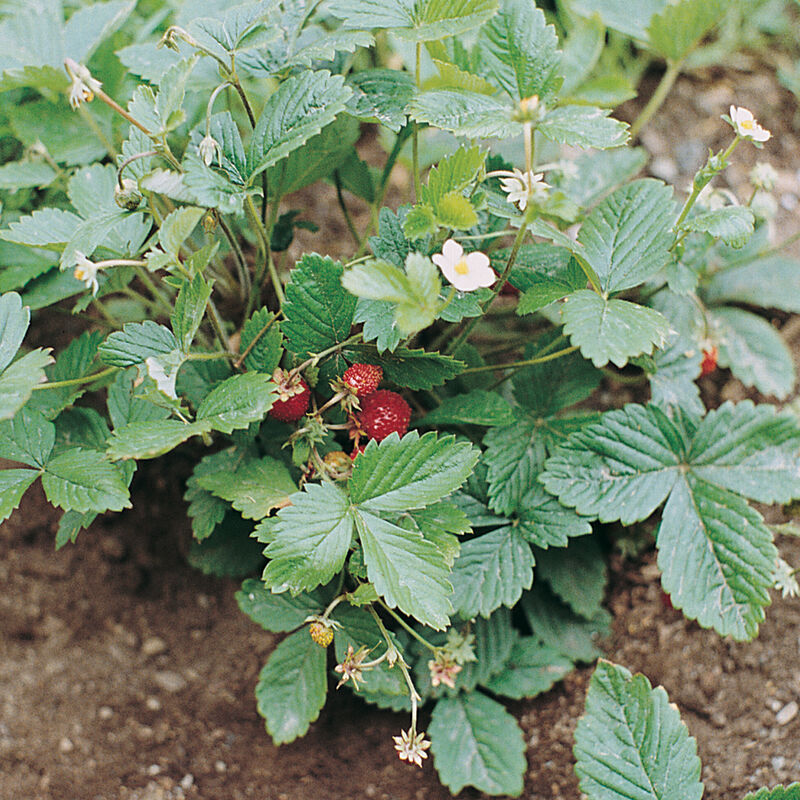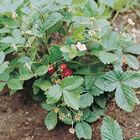Alexandria Strawberry Seed
Alexandria Strawberry Seed
Alpine strawberries from seed.
Day-neutral. A gourmet treat and easy landscape plant. These decorative little plants produce delicious, aromatic red strawberries, about twice the size of wild berries but much smaller than the standard type. Perennials, Alpine strawberries stay compact and produce few runners, making them suitable for rock gardens, path edgings, pots, and window boxes. They begin producing the second spring, sometimes the first fall. Grows best in Zones 5-8.Edible Flowers: Flowers add a mild, strawberry-like flavor if sprinkled on salads or when used as a garnish for drinks and desserts. Specs:
SCIENTIFIC NAME:
Fragaria spp.CULTURE:
Strawberries prefer a sunny to partially shaded location and moist, well-drained soil, richly fertilized with compost or aged manure, and a pH between 6.5-6.8. Prepare beds 6-8 months ahead of planting to get good control over perennial weeds. Avoid fertilizing at time of planting; doing so may trigger tender top growth prone to cold injury.PLANTING (SEEDS):
In the North, sow seeds in March or April; in the South, sow seeds mid-June to early July. Sow seeds thinly. Press seeds into a moist, soilless mix and keep moist until plants emerge in 2-3 weeks. 20-row flats or open flats with drainage are recommended. Keep soil temperature between 60°F (16°C) and 75°F (24°C), if possible. Transplant to plug trays or 1-1 1/2" apart in flats, then to larger pots or planters for retailing full-size plants: 1 plant/3-4" pot; 3-5 plants/8" pot. Transplant outdoors anytime, 1' apart.PLANTING (PLANTS):
Space plants 12-18" apart in rows 3-4' apart. Some growers prefer to plant the crowns with closer spacing (5-9" in-row spacing for single rows or staggered double rows with 10-20" in-row spacing) and to remove all runners during the entire life span of the bed. Set plants with the roots straight down into the soil, making sure the middle of the crown is level with the top of the soil. Irrigate and keep free of weeds. In colder climates, mulch with straw in late fall when plants have started to go dormant to moderate freeze/thaw cycles and heaving. Pull mulch aside in spring when plants start to grow. Mulch may be left in the aisles and around plants to keep the fruit clean and help suppress weeds.HARVEST:
In the North, plants will set fruit from midsummer through October. In the South, plants will set fruit late winter through early June, pausing during the hottest summer months, and then resuming late August through October. Production and berry size may decline when temperatures are consistently above 85°F (29°C). Day-neutral plantings will remain optimally productive for up to two growing seasons once established or may be treated as an annual. Do not renovate day-neutral varieties.STORAGE:
Store unwashed berries at 32°F (0°C) for 3-7 days or freeze for long-term storage.NOTES:
Encourage the plant to put its energy into becoming established by removing all the flower buds for the first 6 weeks after setting out your plants. We also recommend that you remove all the runners during the first year.SPECS:
100 plants/100' row, or 14,520 plants/acre at 12" spacing, rows 3' apart.Johnny's is committed to your success, every step of the way.
We want you, our customer, to be 100% satisfied with all of our seeds, tools, and supplies.
If anything you purchase from us proves unsatisfactory, we will either replace the item or refund the purchase price.





